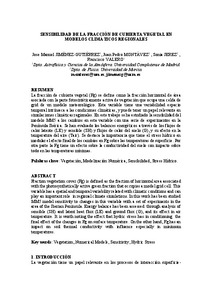Por favor, use este identificador para citar o enlazar este ítem:
http://hdl.handle.net/20.500.11765/9987
Sensibilidad de la fracción de cubierta vegetal en modelos climáticos regionales
| Título : | Sensibilidad de la fracción de cubierta vegetal en modelos climáticos regionales |
| Autor : | Jiménez Gutiérrez, José Manuel; Montávez Gómez, Juan Pedro; Jerez, Sonia; Valero Rodríguez, Francisco |
| Palabras clave : | Vegetación; Modelización numérica; Sensibilidad; Stress hídrico; Vegetation; Numerical models; Sensitivity; Hydric stress |
| Fecha de publicación : | 2018 |
| Editor: | Asociación Española de Climatología; Agencia Estatal de Meteorología |
| Citación : | Montávez Gómez, Juan Pedro, et al. (eds.). El clima: aire, agua, tierra y fuego. Madrid: Asociación Española de Climatología; Agencia Estatal de Meteorología, 2018, p. 987-996 |
| Serie/Num. : | Publicaciones de la Asociación Española de Climatología. Serie A;11 |
| Resumen : | [ES]La fracción de cubierta vegetal (Fg) se define como la fracción horizontal de área asociada con la parte fotosintéticamente activa de vegetación que ocupa una celda de grid de un modelo meteorológico. Esta variable tiene una variabilidad espacio temporal intrínseca a las condiciones climáticas, y puede tener un papel relevante en simulaciones climáticas regionales. En este trabajo se ha estudiado la sensibilidad del modelo MM5 a los cambios en esta variable con una serie de experimentos en la Península Ibérica. Se han evaluado los balances energéticos a través de los flujos de calor latente (LE) y sensible (SH) y flujos de calor del suelo (G), y su efecto en la temperatura del aire (Tair). Se destaca la importancia que tiene el stress hídrico en modular el efecto final de los cambios en Fg sobre las temperaturas de superficie. Por otra parte la Fg tiene un efecto sobre la conductividad del suelo con impacto sobre todo en las temperaturas mínimas. [EN]Fraction vegetation cover (Fg) is defined as the fraction of horizontal area associated with the photosynthetically active green fraction that occupies a model grid cell. This variable has a spatial and temporal variability related with climatic conditions and can play an important role in regional climate simulations. In this work has been studied MM5 model sensitivity to changes in this variable with a set of experiments in the area of the Iberian Peninsula. Energy balance has been assessed through analysis of sensible (SH) and latent heat flux (LE) and ground flux (G), and its effect in air temperature. It is worth noting the effect that hydric stress has in conditioning the final effect of the changes in Fg on surface temperature. On the other hand, Fg has an impact on soil thermal conductivity with influence especially in minimum temperatures. |
| Descripción : | Ponencia presentada en: XI Congreso de la Asociación Española de Climatología celebrado en Cartagena entre el 17 y el 19 de octubre de 2018. |
| URI : | http://hdl.handle.net/20.500.11765/9987 |
| ISBN : | 978-84-7837-098-6 |
| Colecciones: | (2018, Cartagena). XI Congreso AEC |
Ficheros en este ítem:
| Fichero | Descripción | Tamaño | Formato | ||
|---|---|---|---|---|---|
| 0090_XI_2018_JIMENEZ.pdf | 213,63 MB | Adobe PDF |  Visualizar/Abrir |
Los ítems de Arcimis están protegidos por una Licencia Creative Commons, salvo que se indique lo contrario.





